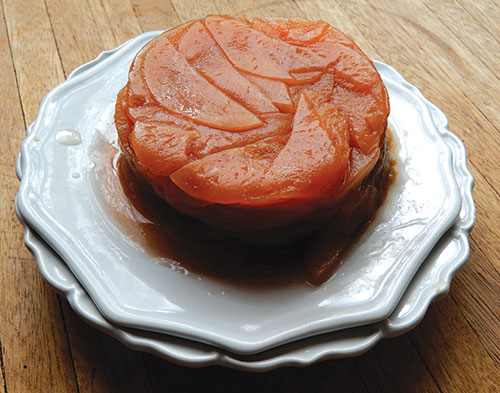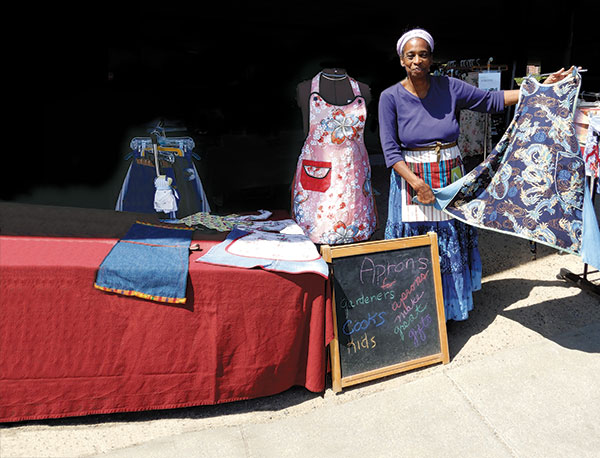They Always Wore Aprons
Lorraine Battle renews a forgotten kitchen tradition
Story and photos by Helen Krayenhoff
“I don’t use an apron.”
Lorraine Battle hears this over and over again as young people walk by the booth where she sells aprons near the Grand Lake Farmers’ Market. Often these same people stop anyway because they are attracted by Lorraine’s smiling, open face or the fabrics she uses.
Then the conversations deepen: “My auntie always wore an apron,” or “My mother has a special one for holiday meals.” Indeed, it seems the women who fed and nurtured them often wore aprons.
Lorraine loves beautiful things, and even more so if they are functional. She told me that aprons evoke ancestral stories, warm memories, and deep emotion. It seems serendipity and coincidence follow Lorraine’s aprons, like recently, when a woman brought Lorraine some special fabric for a custom-made apron. She also brought along some hats from her deceased father that had beautiful buttons she wished to use for the apron’s pockets. When Lorraine delivered the apron, the woman’s mother was there and told about how she had made the buttons on the hats. By coincidence, Lorraine had arrived with the apron on the anniversary of the father’s death.
Lorraine grew up in Philadelphia. She had a close auntie who was never seen without her apron. It was a neighbor who first taught Lorraine to sew, and then the young woman made her own prom dress.
The wider world of food and cooking came into Lorraine’s life in the mid 1980s when a friend convinced her to come work for her media escort business. Lorraine drove authors around when they came to town, taking them from the airport to readings, interviews, and other events. Sometimes she was asked to come up with props for author events, and when those featured cookbook authors, the props might include dishtowels, placemats, and napkins as well as cooked or baked items for television appearances. One day she was asked to drive Mollie Katzen to Julia Child’s TV show, and after that, food and prop styling became regular work for ongoing shows. She worked at KQED with Jacques Pépin for three seasons and Joanne Weir for two.
When Lorraine retired, she thought, “What am I going to do with my time, and what am I going to do with all these beautiful props that I’ve collected?” The answer was to sew those dishtowels, placemats, and napkins into aprons. Over time, this has included making custom aprons for customers or restoring vintage favorites. ♦
You can find Lorraine and her aprons on Lake Park Avenue under the freeway adjacent to Oakland’s Grand Lake Farmers’ Market most Saturdays from 9am to 2pm. To reach Lorraine about buying aprons, send an email to battlelorraine(at)yahoo.com

Lorraine Battle’s Apple Cake
This “cake” is a pure celebration of the apple. Use different varieties—some sweet, some tart.
12–17 apples
Zest of 1 orange, finely grated
1 tablespoon organic sugar
2 5-inch ramekins, lightly buttered
Preheat oven to 300°.
Peel and core apples and slice very thinly by hand, on a mandolin, or in the food processor (use 3mm disk).
Finely grate the zest of one orange and mix zest with sugar.
Build the cakes in the ramekins by carefully piling the slices in differing directions to make as solid a structure as possible. Every third or fourth layer sprinkle a pinch of the orange sugar mixture. When you reach the top, tie a collar of parchment paper around the dish and secure with cotton string. Collar should reach 3-4 inches above the top of the ramekin. Continue building up the apples until you have reached the top of the collar.
Cut a small circle of parchment paper to fit on top of the apples and weigh down apples with a smaller ramekin or another kind of flat-bottomed ovenproof dish that fits inside the paper ring. Place ramekins in a baking dish to catch overflow liquid and place in oven. Bake for at least 3 hours. When the apples have collapsed to below the top of the ramekin, turn off oven, leaving cakes inside to cool gradually, at least an hour or overnight.
To serve, slide knife around edge to loosen and turn over onto a pretty plate. Serve with whipped cream or vanilla ice cream.
Helen Krayenhoff is our Fall Harvest 2017 featured cover artist. See her artist’s statement on the Table of Contents.


